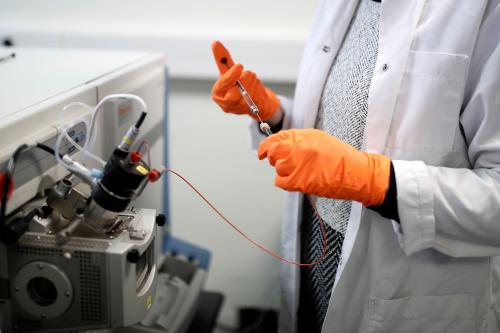This analysis is part of the USC-Brookings Schaeffer Initiative for Health Policy, which is a partnership between the Center for Health Policy at Brookings and the University of Southern California Schaeffer Center for Health Policy & Economics. The Initiative aims to inform the national health care debate with rigorous, evidence-based analysis leading to practical recommendations using the collaborative strengths of USC and Brookings.
This article originally appeared in Health Affairs on November 27, 2017.
Further progress in alternative payment will likely require customizing the approach for particular treatments that account for large amounts of spending. For example, the Center for Medicare and Medicaid Innovation (CMMI) is testing bundled payment for chemotherapy and the Center for Medicaid and Medicare Services has implemented a nationwide competitive bidding process for durable medical equipment. Treatment for neovascular or wet age-related macular degeneration (nAMD) is an area where a change in Medicare Part B payment specific to this procedure has far more potential for substantial reductions in spending than more general proposals for reform in payment for physician-administered drugs.
Treatments For nAMD
nAMD is the leading cause of blindness in the Western world. Prior to the advent of treatment with intraocular (intravitreal) injection of biologic drugs to block the effect of vascular endothelial growth factor (VEGF) in 2005, more than 90 percent of eyes were legally blind within one year of diagnosis despite treatment. Since the introduction of these biologic drugs, commonly referred to as anti-VEGF drugs, the incidence of legal blindness with appropriate, timely and regular treatment is now approximately 10 percent after two years of treatment and 20 percent after five years. Even more remarkably, approximately 50 percent of eyes are able to maintain driving and reading vision after up to five years of treatment.
The beneficial effects of anti-VEGF drugs were quickly embraced by ophthalmologists. The number of intravitreal injections performed in Medicare fee for service increased from 252,000 in 2005 to 3.2 million in 2016. Currently, there are three drugs commonly used for anti-VEGF therapy: bevacizumab (Avastin), ranibizumab (Lucentis), and aflibercept (Eylea). Both Lucentis and Eylea are U.S. Food and Drug Administration (FDA) approved for treatment of nAMD. Avastin is FDA approved for the treatment of various cancers, but not FDA approved for any eye disease, meaning that ocular use of Avastin is considered off label. Ophthalmologists obtain Avastin in repackaged syringes from compounding pharmacies.
If there are two FDA-approved drugs for nAMD, why would ophthalmologists choose to use Avastin, which accounts for almost half of Medicare treatments with anti-VEGF therapy? The first reason relates to access and the second is cost. In July 2005, the first phase III clinical trial data for nAMD for Lucentis were presented at a national ophthalmology meeting. The data demonstrated for the first time that a treatment could not only prevent further loss of vision but actually improve vision. Ophthalmologists were elated, but then frustrated by the realization that the FDA approval process would delay access for at least a year.
However, at the same meeting an ophthalmologist, named Phil Rosenfeld, presented his experience using repackaged Avastin. Dr. Rosenfeld chose to test Avastin because it was a potent anti-VEGF agent and available since it was FDA approved for cancer treatment. In fact, Lucentis is derived from Avastin; both drugs are made by Genentech. In his relatively small study, Dr. Rosenfeld demonstrated that Avastin prevented visual loss and improved vision. This revelation changed care overnight. Ophthalmologists returning from the meeting immediately sought out compounding pharmacies to provide Avastin. Since Avastin was not FDA approved for eye care, Medicare and commercial insurers initially did not pay for the drug. Ophthalmologists could obtain Avastin for less than $50 and were willing to provide the treatment without payment for the drug from Medicare.
Soon ophthalmologists were observing the same beneficial effects described by Dr. Rosenfeld and Avastin became the standard of care. As more experience was gained, and favorable scientific reports accrued, the American Academy of Ophthalmology and local ophthalmologists requested local coverage from the Medicare carriers, which one by one took the unusual step of providing coverage for an off-label treatment. Between July 2005 and the FDA approval of Lucentis in July 2006, ophthalmologists accumulated a vast clinical experience of hundreds of thousands of Avastin injections and there was widespread clinical consensus that the treatment was safe and effective for the vast majority of patients.
Three Effective Drugs With Wide Variation In Prices
With the FDA approval and availability of Lucentis, ophthalmologists now had two useful treatments, but there was one large difference. Avastin was priced at approximately $50 and Lucentis was priced at $1,950 per injection. Under Medicare Part B payment policy, the allowable payment to physicians was $2,078 and patients without supplemental coverage were responsible for more than $400 in coinsurance. With patients needing injections from six to twelve times a year and sometimes in both eyes, many could not afford the drug. Furthermore, ophthalmologists for the first time were responsible for the purchase, inventory, and billing of expensive drugs. Therefore, many ophthalmologists decided to stay with Avastin while others were bothered by the lack of a definitive clinical trial comparing the two drugs and accepted the financial risks and started using Lucentis. The question of relative efficacy and safety of the two drugs led to the National Institute of Health-sponsored Comparison of nAMD Treatment Trials (CATT) study, which demonstrated in 2011 that when administered using the same dosing regimen, Avastin and Lucentis were comparable.
In 2011, Eylea was FDA approved for nAMD and was priced at $1,850 per dose. In the clinical trials leading to its approval, Eylea was shown to be comparable to Lucentis. To date, there are no large comparative studies between Eylea and Avastin. All three drugs are now commonly used. The best available data on the relative proportion of use for each drug comes from the IRIS Registry (Intelligent Research in Sight)of the American Academy of Ophthalmology. From 2013 to 2016 across 6,259,470 injections, Avastin accounted for 46 percent, Eylea for 32 percent, and Lucentis for 20 percent (with the remainder for lesser used drugs).
Changing Payment Policy
Since Avastin is used nearly 46 percent of the time and costs a fraction of Eylea or Lucentis, its use is already saving taxpayers and beneficiaries very substantial amounts of money. But a lot more could be saved. Medicare reimbursement policies do not encourage the use of Avastin and, indeed, strongly discourage it. Under current policies for all physician-administered drugs (also known as “Part B drugs”), allowed charges are pegged at 106 percent of the Average Sales Price (ASP). So a practice obtaining the drug at ASP can earn a margin of about $10 per injection using Avastin or $117 or $111 using Eylea or Lucentis. (A separate payment is made to cover the physician’s administration of the drug; that does not vary by the specific drug used.) The financial incentive to opt for one of the two more expensive drugs is very large and clearly favors the more expensive drugs.
Policymakers have discussed reforms in Medicare payment for physician-administered drugs. CMMI proposed a demonstration in 2016 in which the 6 percent margin would be reduced to 2.5 percent and would offset in the aggregate with a uniform dollar payment. The proposal had to be withdrawn in the face of widespread opposition by the pharmaceutical industry and physicians, reflected by efforts in Congress to prohibit the demonstration. One of the concerns raised was that acquisition prices by medical practices varied and with only a 2.5 percent margin, some practices would lose money. Concerns were exacerbated by the current sequester reducing the overall Medicare payment by 2 percent (although it’s worth noting manufacturers have a strong incentive for all expensive drugs to reduce prices to keep such practices in the black
But even if such a demonstration had proceeded and led to a permanent revision in payment policy, it still would have left a strong incentive to choose one of the more expensive drugs. While the incentive would have been reduced, it would have remained substantial. For treatment of nAMD, particularly in light of the results of the CATT trial, Medicare could pay ophthalmologists the same dollar amount as a markup for all three drugs instead of the current 6 percent–or even a higher amount for Avastin as is now being done by some commercial payers. We believe that such a policy would save taxpayers and patients substantial amounts of money without reductions in quality. (Some Medicare Advantage are requiring a prior authorization for use of Lucentis or Eylea, which is an approach generally not available to traditional Medicare.)
Why Specificity May Be A Better Approach
Although such approaches would make good policy for treatment for nAMD, this may not be the case for treatments of other conditions. Treatment for nAMD may be unusual in having two or more drugs that are not generics or biosimilars but that are so similar in the indications for treatment as well as their effectiveness and safety. But with annual Medicare spending for these three drugs totaling $3.2 billion, a policy that applies only to these treatments can make a substantial contribution to value.
As alternative payment approaches expand beyond accountable care organizations and bundled payment for inpatient procedures, further progress likely will require more custom approaches for particular areas of care. CMMI has been moving in this direction with a demonstration particular to chemotherapy and other demonstrations for particular types of services. Indeed, the demonstration for Part B drugs that was withdrawn included authorities for payment approaches for specific drug classes and even specific drugs. Although proceeding in this direction will take substantial staff resources at CMMI, this may be an important part of a strategy to increase the role of value in payment for medical care.









Commentary
Treatment-specific payment approaches: The case of macular degeneration
November 27, 2017